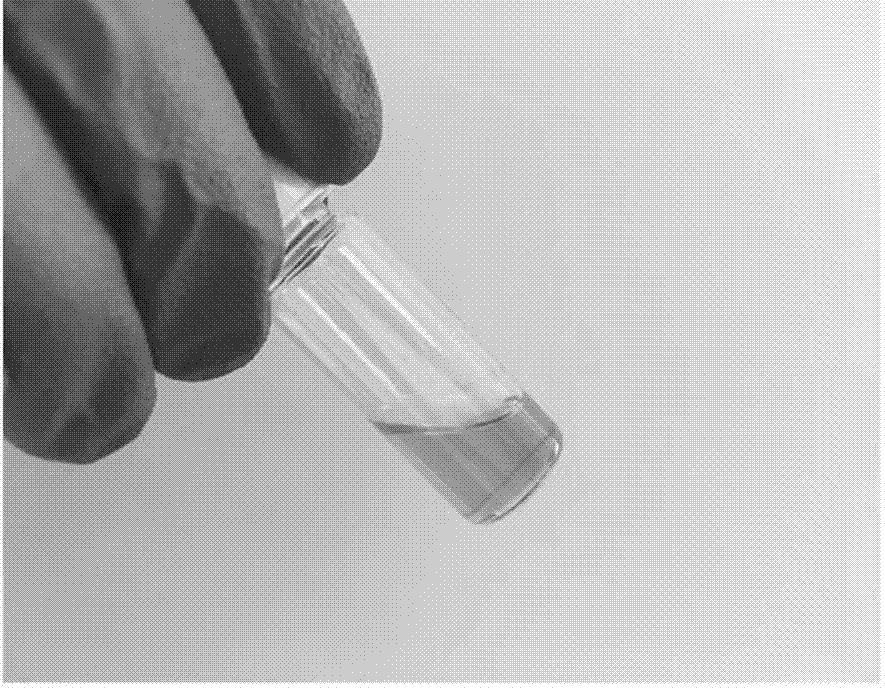Application of alcohol soluble fullerene derivative in perovskite solar cell
A technology of fullerene derivatives and solar cells, applied in the preparation of organic compounds, circuits, photovoltaic power generation, etc., can solve the problems of increasing device manufacturing costs, low voltage, affecting device efficiency, etc., and achieve improved photoelectric conversion efficiency, high Good battery performance and dispersibility
- Summary
- Abstract
- Description
- Claims
- Application Information
AI Technical Summary
Problems solved by technology
Method used
Image
Examples
Embodiment 1
[0059] A preparation method of alcohol-soluble fullerene derivatives specifically includes the following steps:
[0060] (1) Under alkaline conditions, react triethylene glycol monomethyl ether with p-toluenesulfonyl chloride to obtain 2-(2-methoxyethoxy)ethoxyethyl p-toluenesulfonic acid;
[0061] (2) In a polar solvent, 2-(2-methoxyethoxy)ethoxyethyl p-toluenesulfonic acid reacts with methyl 3,4,5-trihydroxybenzoate to obtain 3,4,5- Methyl tris((2-(2-methoxyethoxy)ethoxy)ethoxy)benzoate;
[0062] (3) 3,4,5-tris(2-(2-methoxyethoxy)ethoxy)ethoxy benzoic acid methyl ester is reduced by LiAlH4 under ice bath conditions to obtain 3,4,5-tris ((2-(2-Methoxyethoxy)ethoxy)ethoxy)benzol;
[0063] (4) Using N,N-lutidine (DMAP), p-toluenesulfonic acid (PTSA), and N,N-diisopropylamide (DIPC) as catalysts, 3,4,5-tris(2-( 2-Methoxyethoxy)ethoxy)ethoxybenzol and [6,6]-C 60 -Phenylbutyric acid (PCBA), the esterification reaction takes place to obtain the final product, which is [6,6]-C61-phenylbut...
Embodiment 2
[0068] A method for preparing a perovskite solar cell includes the following steps:
[0069] 1) First prepare PbI 2 DMF solution and MAI isopropanol solution doped with 0.1% alcohol-soluble fullerene derivative PCBB-6C-EG;
[0070] 2) Spin-coating a hole transport layer on clean conductive glass;
[0071] 3) Use solution spin coating processing method to prepare PbI 2 The solution is spin-coated on the dried hole transport layer, and then on the dried PbI 2 Spin-coating the MAI isopropanol solution doped with alcohol-soluble fullerene derivatives on the film;
[0072] 4) Anneal the obtained flat film on a hot stage at 135℃ to obtain perovskite crystals; used for SEM test; see image 3 Shown is the SEM morphology of the perovskite surface prepared after doping with 0.1% alcohol-soluble fullerene derivatives. It can be seen from the figure that the doped perovskite grains are relatively uniform and dense, and the A relatively large crystal grain can be formed, and a relatively high devi...
Embodiment 3
[0074] The conductive glass is sonicated with deionized water, acetone, and isopropanol, and the ultrasonic glass is placed in an oven to dry; then a layer of hole transport layer is spin-coated; a two-step method is used on the hole transport layer. The perovskite active layer is prepared by annealing at 135°C, and the obtained film can be used for XRD testing.
[0075] See Figure 4 Shown are the XRD curves of PCBB-6C-EG doped with 0%, 0.01%, 0.1% and 1%. It can be seen from the figure that with the incorporation of PCBB-6C-EG, the resulting XRD There is a significant increase in the peak intensity, which shows that PCBB-6C-EG can assist the growth of perovskite crystals and help to grow larger grains, which is also consistent with the SEM surface topography.
PUM
| Property | Measurement | Unit |
|---|---|---|
| thickness | aaaaa | aaaaa |
| concentration | aaaaa | aaaaa |
| conversion efficiency | aaaaa | aaaaa |
Abstract
Description
Claims
Application Information
 Login to View More
Login to View More - R&D
- Intellectual Property
- Life Sciences
- Materials
- Tech Scout
- Unparalleled Data Quality
- Higher Quality Content
- 60% Fewer Hallucinations
Browse by: Latest US Patents, China's latest patents, Technical Efficacy Thesaurus, Application Domain, Technology Topic, Popular Technical Reports.
© 2025 PatSnap. All rights reserved.Legal|Privacy policy|Modern Slavery Act Transparency Statement|Sitemap|About US| Contact US: help@patsnap.com



